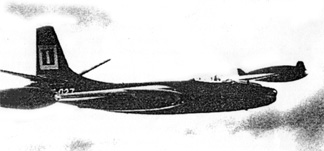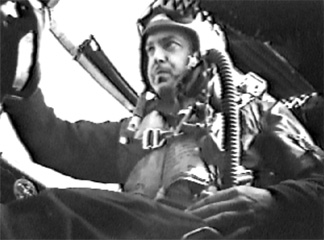Midnight Mission
|
|||||||||
|
Photos from the author’s collection and Warren M. Bodie Page 6 of 7 Pages
|
|||||||||
| We had now coasted out, cruising along at 29,000 feet with our Navel escort in place.The threat of further intercepts was remote. Very seldom did the North Koreans or Chinese extend their air threat out over the Sea of Japan. Apparently they simply did not have the radar capability to control their operations. No point in keeping the Navy escort any longer. Might as well let them return to their carrier.
"Amber Leader, Raven One. Be advised you are now clear to discontinue escort. Much obliged for the help." "Amber One came back on. "Rog, Raven One, be advised we will break left in a descending turn. You are cleared to Komatsu Control, frequency 242.5, over." Roger Amber, leaving frequency. Again, thanks, and good luck." We were now on our own, heading for the coast-in point in the vicinity of Komatsu on the main island of Honshu, Japan. Tail winds were very favorable, allowing us to clip along at 610 kts. ground speed. ETA at Yokota was now 1:05 away. |
|||||||||
| As we continued a cruise climb configuration, attempting to gain every foot of precious altitude to conserve fuel, I had one never-to-be-forgotten experience.
In the RB-45, the pilot and copilot's life raft consisted of a seat pack attached to the base of a back parachute. In other words, you sat on it. If ejection became necessary (both pilot and copilot seats were ejectable), the raft hung |
|||||||||
 |
|||||||||
|
Photo Ctsy. Howard Myers |
|||||||||
| below the chute harness and was inflated by a CO-2 cylinder, which the pilot would activate just before hitting the drink.
As we were about midway to landfall, my life raft suddenly and unexplainably started to inflate. The normal head clearance between the pilots hard helmet and the canopy is about four inches. As the raft continued inflating, I began to rise in my seat to where my head not only struck the canopy, but I was rapidly being squeezed into a |
|||||||||
| position where I could no longer control the aircraft. Pressed up against the glass, I called the copilot to take control while I tried to figure out what to do.
I could not control the flow of CO-2, as the cylinder had apparently activated on its own. I was being squeezed more and more against the canopy by an out-of-control life raft that had a mind of its own. The cockpit in the RB-45 was about equal to a good sized fighter cockpit, with no room to spare. I had to do something or be shoved right through the top. An inflated liferaft in an already cramped cockpit was impossible to comprehend. |
|||||||||
 |
|||||||||
|
Photo Ctsy. Howard Myrs |
|||||||||
| What to do? It suddenly occurred to me that the only solution was to deflate the raft, but the deflating valve was nowhere to be felt and I had to feel my way, as it was pitch black outside and we were in the clouds.
As I was groping for the release valve, my hand suddenly struck my survival knife in the right slot of my flying suit leg. Without hesitation, I drew the knife out of its holder and began stabbing the life raft. After several swipes with the blade, I finally managed to deflate the raft. As the rubber slowly expelled its air, I settled back down on my seat with a mighty cramped neck and an otherwise unusable life raft. I had never expected to stab a life raft to death. Then I had a momentary thought. What if we had to bail out or ditch in that 32 degree water, and me with no life raft? By the time all this transpired, we were within 20 minutes of the Japanese coast. It would be the longest 20 minutes I ever spent. "Hello Oak Hill Able, Raven One here. Do you read?" "Roger Raven One, Oak Hill Able here. Be advised QSY (transfer frequency) to Komatsu Control for penetration instructions squawk 3-2, over." "Roger Oak Hill Able, Raven here. Switching to channel 4, squawking as advised, over and out." We were now inbound to the northwest coast of the island of Honshu with a coast-in point of Wajima, a town about 180 miles from Yokota. "Komatsu Control, Raven One here. Be advised we are estimating Wajima in 20 minutes. Please relay the Yokota weather, over." "Roger Raven One. Komatsu Control here. Be advised we have you on radar, squawk 1-1 for positive ID. Roger Raven, just saw your change in squawk, continue heading 150 degrees, proceed to Komatsu RBN frequency 255 kc, identification Mike Kilo. Be advised further that the weather at Yokota is ceiling 300 feet, visibility 1/4 mile, light snow, winds northwest 10 kts., over." Page 1, Page 2, Page 3, Page 4, Page 5, Page 6, Page 7 To Go To — RB-45 Home — or — Miscellaneous RB-45 Facts and Figures Home - Contact Us - Cold War Hist. - 91st SRS Hist. - Stardust 40 Mission Story |
|||||||||